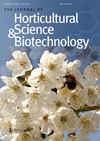Biomass accumulation and leaf shape can be modulated by an exogenous spray of 6-benzylaminopurine in the ornamental foliage plant, Monstera deliciosa (Liebm.)
IF 2.1
4区 农林科学
Q2 HORTICULTURE
Journal of Horticultural Science & Biotechnology
Pub Date : 2014-01-01
DOI:10.1080/14620316.2014.11513059
引用次数: 3
Abstract
Summary The productivity of ornamental foliage plants is related to their capacity to increase their leaf number and leaf size. In Monstera deliciosa, a change in leaf shape is also a pre-requisite for successful marketing. The aim of this work was to describe the effects of different concentrations of exogenous 6-benzylaminopurine (BAP; 5, 50, 100, or 200 mg l–1) on the control of both leaf size and leaf shape in M. deliciosa, and the impact of these changes on commercial plant productivity. We found an increase of between 15.4 – 23.1% in the rate of leaf appearance (RLA), which reflected a shortening of the phyllochron, and an increase of between 17.5 – 34.9% in the relative rate of leaf area expansion (RLAE) at most of the BAP concentrations tested. This resulted in higher biomass accumulation in both roots and shoots through an increase of between 5.4 – 7.9% in the relative growth rate (RGR), mainly associated with higher net assimilation rates (NAR; increases from 9.0-fold to 11.0-fold) and increased photoassimilate partitioning to the shoots. The most important result of this work was the early appearance of perforated leaf laminae in M. deliciosa plants sprayed with 50 – 200 mg l–1 BAP, which made them ready for sale.外源喷淋6-苄基氨基嘌呤可以调节观赏叶植物Monstera deliciosa的生物量积累和叶片形状。
观赏叶植物的生产力与其增加叶片数量和叶片大小的能力有关。在“美味怪兽”中,叶子形状的变化也是成功营销的先决条件。这项工作的目的是描述不同浓度的外源6-苄基氨基嘌呤(BAP;5、50、100或200 mg l-1)对香豆叶大小和叶形的控制,以及这些变化对商品植物生产力的影响。结果表明,在大多数BAP浓度下,叶片外观率(RLA)增加了15.4 ~ 23.1%,反映了叶长的缩短;相对叶面积扩张率(RLAE)增加了17.5 ~ 34.9%。相对生长率(RGR)增加了5.4 - 7.9%,导致根和茎的生物量积累增加,主要与较高的净同化率(NAR;从9.0倍增加到11.0倍),增加了对茎部的光同化分配。本研究最重要的结果是,喷施50 ~ 200 mg l-1 BAP后,香豆科植物的叶面较早出现穿孔,可用于销售。
本文章由计算机程序翻译,如有差异,请以英文原文为准。
求助全文
约1分钟内获得全文
求助全文
来源期刊
CiteScore
3.90
自引率
5.30%
发文量
67
审稿时长
3 months
期刊介绍:
The Journal of Horticultural Science and Biotechnology is an international, peer-reviewed journal, which publishes original research contributions into the production, improvement and utilisation of horticultural crops. It aims to provide scientific knowledge of interest to those engaged in scientific research and the practice of horticulture. The scope of the journal includes studies on fruit and other perennial crops, vegetables and ornamentals grown in temperate or tropical regions and their use in commercial, amenity or urban horticulture. Papers, including reviews, that give new insights into plant and crop growth, yield, quality and response to the environment, are welcome, including those arising from technological innovation and developments in crop genome sequencing and other biotechnological advances.

 求助内容:
求助内容: 应助结果提醒方式:
应助结果提醒方式:


